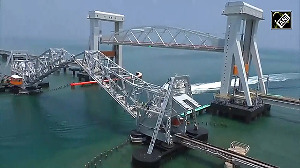Zudio was the standout performer as it tapped into the pentup demand in small-town India, at a pace never seen before, notes Indrajit Gupta, co-founder and director, Founding Fuel.

India's massive consumer market represents one of the biggest open market opportunities in the world. We've known this for the past 10 years and more. Yet the confusion that grips marketers -- local and global -- refuses to go.
Chasing Zudio
With apparel and lifestyle brand Zudio, Noel Tata's Trent showed the courage to step out of the comfort of operating in top-tier markets.
Zudio was the standout performer last year as it used discipline and a great sense of value to tap into the pentup demand in small-town India, at a pace never seen before.
Zudio's runaway growth is predicated on creating aspirational yet affordable fast fashion for young couples in the age group 28-35 in towns where organised retail is yet to enter.
Almost all products -- apparel and accessories -- are below the Rs 1,000 price point.
The store economics -- the location, the store design, the focus on fast-moving items -- have been planned meticulously to ensure that the business reaches inventory turns that are way above the average.
By the end of 2023, revenues are estimated to be in excess of Rs 4,000 crore (Rs 40 billion) from its network of more than 400 stores.
The stage is now set for a big battle between Reliance and Trent this year.
Reliance is partnering Chinese mega fast fashion brand Shein, which was valued at $100 billion -- more than the combined worth of H&M and Zara.
A new team based in Bengaluru will aim to play catchup with Trent's enormous success with Zudio.
What's interesting is that Zudio's unique yet painstakingly detailed and integrated business model and an astute understanding of the aspirational small-town consumer has been driven by two expat leaders.

Disney's strategic retreat
If India is the last big frontier for most multinationals, what prompted Disney to push ahead with its plans to put its entire streaming (Disney+Hotstar) and television business (Star TV) on the block?
It isn't just Disney. Most streaming services like Netflix have hit the wall. They made merry during the pandemic, and commissioned new original shows and movies. Today, they are licking their chops. Their served market -- consisting of people like us -- is now saturated.

The nub of the issue
The inability to expand the streaming market beyond India One. Creating exclusive content that appeals to small-town India and also prompts them to buy a subscription plan has proven to be a challenge.
Spotify recently learnt it the hard way. They were initially equally amazed at the sheer size of its user base. But after two years of investment, they realised that converting a user used to free content in small-town UP to pay extra for subscription was an inordinately tough task.
Only a few are willing to convert. The subscription opportunity is shallow, not only in small-town India but also across digital business media platforms.
The initial spurt in subscriptions is now giving way to plateauing growth rates and a high churn.
This begs the question
How well do creative leaders in streaming platforms or even digital business media know their prospective audience?
Not quite well, it seems. As the Zudio case shows, achieving product-market fit -- and also making money sustainably -- is clearly easier said than done. And venture capitalists are unlikely to fund losses forever.

Air India's moment of truth
By January 27, 2024, the Tata group will have had two years to fix the troubled Air India.
Initially, expectations ran high that the erstwhile flag carrier would be quickly able to restore much of its lost charm and loyalty.
I had argued in the past that, given its decrepit state of operations, any quick wins would be well nigh impossible.
Simply ordering a large brand new fleet was the easy part.
First of all, aircraft deliveries take time. Fixing the interiors of the existing aircraft and getting grounded aircraft to fly again were tough, plus getting enough trained crew in place was an even bigger headache.
That's exactly how the turnaround saga has panned out. Now, the delivery of new airline orders has begun. The staff have a new livery.
New long-haul, direct flights to a variety of locations across the US and Europe have gradually fallen into place. But it may still take more time to gradually restore consumer confidence in Air India.
By all indication, it will remain one of the most closely watched turnarounds in recent corporate history.
In the interim, the Tata group has been fortunately able to use Vistara to burnish its ability to offer a premium, full-service experience to flyers.
If the eventual plan is to create a master brand in Air India, and subsume all the other brands -- Vistara, Air India Express, and Air Asia -- under it, how that exercise is carried out remains to be seen.
After the pandemic, Vistara has re-emerged as a strong, distinctive brand and is preferred by most business travellers. Snuffing it out or bringing it under the Air India umbrella may not be easy.
Feature Presentation: Ashish Narsale/Rediff.com












 © 2025
© 2025